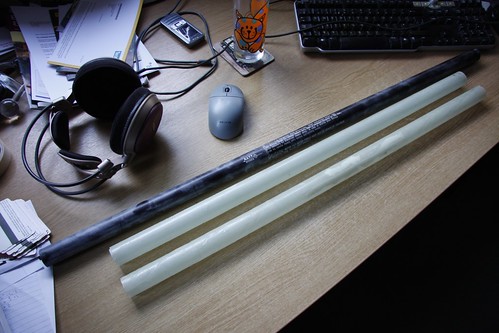WiK
Site Admin
- Joined
- Jan 18, 2009
- Messages
- 2,642
- Reaction score
- 4
I figured it was about time I started a build thread on TRF 2.0! 
Anyway, I've had this I90 hybrid motor for a couple of years now but not gotten around to building a rocket for it. At nearly a meter long and 29mm diameter, it's not something you can just shove in your average LOC/PML kit.
So I'm going for a minimum diameter design. Home made fiberglass tubing, glassed foam Von Karman nosecone, glassed balsa fins. Dual deploy using a Perfectflite MiniAlt and a Beeline tracker. I'm hoping it'll break 10,000ft, which should be enough to get me the UK I altitude record as well.

And just for fun, a couple of the 'glass tubes and the motor itself. The white stuff on the motor is talcum powder from being used as the mandrel for the tubes. I'll probably make another length of tube this week, as the outside of one came out slightly wrinkly and it'll be handy to have some spare.

Because the length of any section of tube is limited by using the motor as a mandrel, and the fact I have to keep things short so they're easy to transport by train to launches without looking too suspicious, I'm going to have to split the tube somewhere along the motor. The plan is to have a lower section with the fins completely loose, and use the motor as a coupler. The forward closure has a threaded hole in the top, so I'm going to screw that into a bolt in a bulkhead in the upper section, which retains the motor and joins the two bits of tube nicely, with the thrust ring stopping the fin section flying off the back. At least that's how I see it in my head...
One thing I'm not certain about is the fin size. It's way overstable at the moment, and I did have the fins a fair bit smaller, but then I read an article in the Apogee newsletter about stability of long skinny rockets, and that recommended going for fins a bit larger than were necessary to make it stable in Rocksim, to account for the forces on the rocket body when flying at a non-zero angle of attack. Does anyone else have any thoughts?
Hopefully I can get the Beeline ordered sometime this week and actually get on with some building!
Edit: Rough sim file attached.
Cheers,
Phil
View attachment 29mm min diam 2.rkt
Anyway, I've had this I90 hybrid motor for a couple of years now but not gotten around to building a rocket for it. At nearly a meter long and 29mm diameter, it's not something you can just shove in your average LOC/PML kit.
So I'm going for a minimum diameter design. Home made fiberglass tubing, glassed foam Von Karman nosecone, glassed balsa fins. Dual deploy using a Perfectflite MiniAlt and a Beeline tracker. I'm hoping it'll break 10,000ft, which should be enough to get me the UK I altitude record as well.

And just for fun, a couple of the 'glass tubes and the motor itself. The white stuff on the motor is talcum powder from being used as the mandrel for the tubes. I'll probably make another length of tube this week, as the outside of one came out slightly wrinkly and it'll be handy to have some spare.

Because the length of any section of tube is limited by using the motor as a mandrel, and the fact I have to keep things short so they're easy to transport by train to launches without looking too suspicious, I'm going to have to split the tube somewhere along the motor. The plan is to have a lower section with the fins completely loose, and use the motor as a coupler. The forward closure has a threaded hole in the top, so I'm going to screw that into a bolt in a bulkhead in the upper section, which retains the motor and joins the two bits of tube nicely, with the thrust ring stopping the fin section flying off the back. At least that's how I see it in my head...
One thing I'm not certain about is the fin size. It's way overstable at the moment, and I did have the fins a fair bit smaller, but then I read an article in the Apogee newsletter about stability of long skinny rockets, and that recommended going for fins a bit larger than were necessary to make it stable in Rocksim, to account for the forces on the rocket body when flying at a non-zero angle of attack. Does anyone else have any thoughts?
Hopefully I can get the Beeline ordered sometime this week and actually get on with some building!
Edit: Rough sim file attached.
Cheers,
Phil
View attachment 29mm min diam 2.rkt
Last edited:


